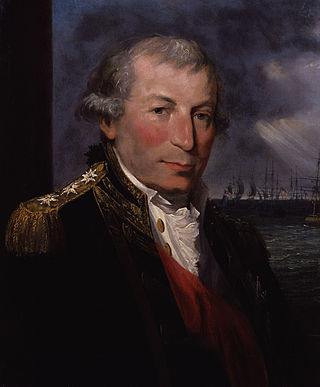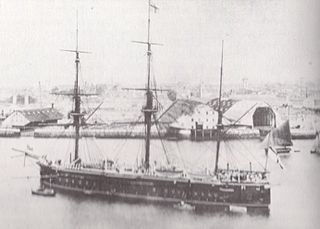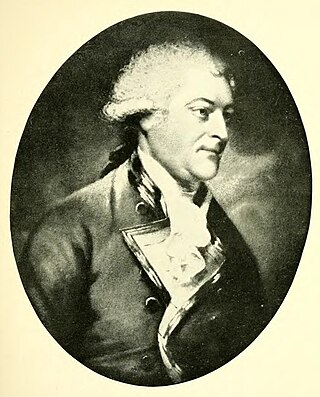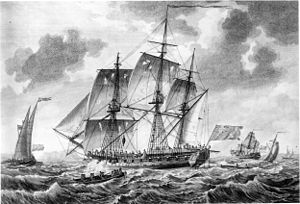
The Battle of Cape St. Vincent was a naval battle that took place off the southern coast of Portugal on 16 January 1780 during the American Revolutionary War. A British fleet under Admiral Sir George Rodney defeated a Spanish squadron under Don Juan de Lángara. The battle is sometimes referred to as the Moonlight Battle because it was unusual for naval battles in the Age of Sail to take place at night. It was also the first major naval victory for the British over their European enemies in the war and proved the value of copper-sheathing the hulls of warships.

Admiral of the Fleet John Jervis, 1st Earl of St Vincent was an admiral in the Royal Navy and Member of Parliament in the United Kingdom. Jervis served throughout the latter half of the 18th century and into the 19th, and was an active commander during the Seven Years' War, American War of Independence, French Revolutionary War and the Napoleonic Wars. He is best known for his victory at the 1797 Battle of Cape Saint Vincent, from which he earned his titles, and as a patron of Horatio Nelson.

HMS Agamemnon was a 64-gun third-rate ship of the line of the British Royal Navy. She saw service in the American Revolutionary War, French Revolutionary and Napoleonic Wars, and fought in many of the major naval battles of those conflicts. She is remembered as being Nelson's favourite ship, and was named after the mythical ancient Greek king Agamemnon, being the first ship of the Royal Navy to bear the name.

The Swiftsure class battleships of the late Victorian era were broadside ironclads designed and built specifically for service as Flagships on the Pacific station.

Copper sheathing is a method for protecting the hull of a wooden vessel from attack by shipworm, barnacles and other marine growth through the use of copper plates affixed to the surface of the hull, below the waterline. It was pioneered and developed by the Royal Navy during the 18th century. In antiquity, ancient Greeks used lead plates to protect the underwater hull.

HMS Coventry was a 28-gun sixth-rate frigate of the Royal Navy, launched in 1757 and in active service as a privateer hunter during the Seven Years' War, and as part of the British fleet in India during the Anglo-French War. After seventeen years' in British service she was captured by the French in 1783, off Ganjam in the Bay of Bengal. Thereafter she spent two years as part of the French Navy until January 1785 when she was removed from service at the port of Brest. She was broken up in 1786.

Georges-René Le Peley de Pléville was the governor of the port of Marseilles, a French admiral, minister for the navy and the colonies from 15 July 1797 to 27 April 1798, a senator, a knight of the Order of St Louis and the Order of Cincinnatus, and one of the first Grand officiers of the Légion d'honneur.

The Foudroyant was an 80-gun ship of the line of the French Navy. She was later captured and served in the Royal Navy as the Third Rate HMS Foudroyant.

The Comus class was a class of Royal Navy steam corvettes, re-classified as third-class cruisers in 1888. All were built between 1878 and 1881. The class exemplifies the transitional nature of the late Victorian navy. In design, materials, armament, and propulsion the class members resemble their wooden sailing antecedents, but blended with characteristics of the all-metal mastless steam cruisers which followed.

HMS Victory is a 104-gun first-rate ship of the line of the Royal Navy. She was ordered in 1758, laid down in 1759, and launched in 1765. With 246 years of service as of 2024, she is the world's oldest naval vessel still in commission.

Philemon Pownoll of Sharpham in the parish of Ashprington in Devon, England, was an officer of the Royal Navy who saw service during the War of the Austrian Succession, the Seven Years' War and the American War of Independence, rising to the rank of post-captain.

HMS Lizard was a 28-gun Coventry-class sixth-rate frigate of the Royal Navy, in service from 1757 to 1828. Named after the Lizard, a peninsula in southern Cornwall, she was a broad-beamed and sturdy vessel designed for lengthy periods at sea. Her crewing complement was 200 and, when fully equipped, she was armed with 24 nine-pounder cannons, supported by four three-pounders and twelve 1⁄2-pounder swivel guns. Despite her sturdy build, she was plagued with maintenance problems and had to be repeatedly removed from service for repair.

HMS Trent was a 28-gun Coventry-class sixth-rate frigate of the Royal Navy.

HMS Levant was a 28-gun sixth-rate frigate of the Coventry class, which saw Royal Navy service against France in the Seven Years' War, and against France, Spain and the American colonies during the American Revolutionary War. Principally a hunter of privateers, she was also designed to be a match for small French frigates, but with a broader hull and sturdier build at the expense of some speed and manoeuvrability. Launched in 1758, Levant was assigned to the Royal Navy's Jamaica station from 1759 and proved her worth by defeating nine French vessels during her first three years at sea. She was also part of the British expedition against Martinique in 1762 but played no role in the landings or subsequent defeat of French forces at Fort Royal.

Admiral Robert Linzee was an officer of the Royal Navy who served during the American War of Independence, and the French Revolutionary and Napoleonic Wars.

Galvanic corrosion is an electrochemical process in which one metal corrodes preferentially when it is in electrical contact with another, in the presence of an electrolyte. A similar galvanic reaction is exploited in primary cells to generate a useful electrical voltage to power portable devices. This phenomenon is named after Italian physician Luigi Galvani (1737–1798).

HMSEmerald was a 36-gun Amazon-class fifth rate frigate that Sir William Rule designed in 1794 for the Royal Navy. The Admiralty ordered her construction towards the end of May 1794 and work began the following month at Northfleet dockyard. She was completed on 12 October 1795 and joined Admiral John Jervis's fleet in the Mediterranean.

HMS Canada was a Comus-class screw corvette of the Royal Navy. She was launched in 1881 and sold for scrap in 1897. Her bow badge was removed prior to being sold for scrap and is displayed in the Maritime Museum of British Columbia.
Velters Cornewall Berkeley (1754–1804) was an officer in the Royal Navy. He served in both the American and French Revolutionary Wars but never rose above the rank of Captain. He died at his home in Oxford in 1804, aged 50.

HMS Amazon was a 32-gun fifth-rate frigate of the Royal Navy, armed with a main battery of twenty-six 12 pounders and launched at Rotherhithe shipyard in 1773. She was first commissioned in February 1776 for war in America where she took part in operations against New York. Returning to England in February 1779, Amazon underwent a refit before serving in the English Channel and North Sea. In April 1780, she sailed to the Leeward Islands where, in October, she was almost wrecked in a hurricane.


















